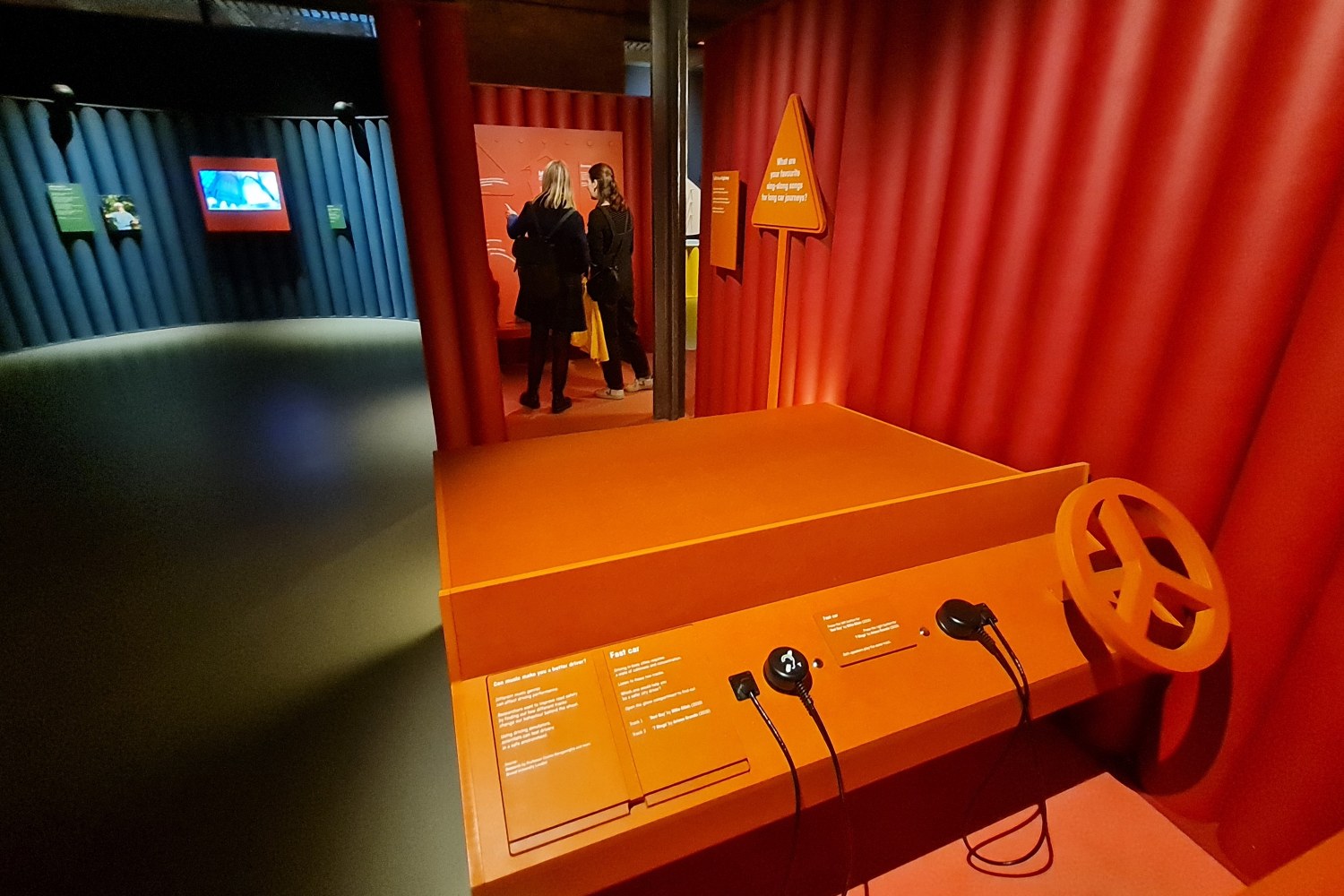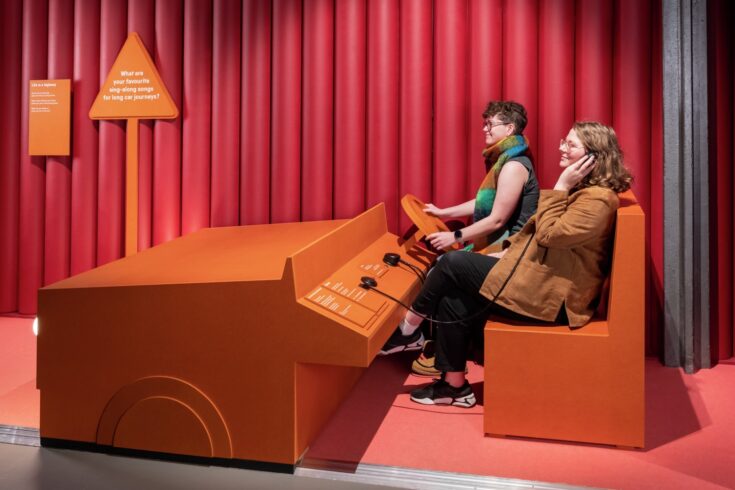Many of us stream music while we’re in the car, but did you know your choice of playlist can affect the safety of your driving?
Economic and Social Research Council (ESRC) funded research by Professor Costas Karageorghis, Brunel University London found the tempo, loudness and lyrics of music can influence driving behaviours. Playing certain genres, such as rap and grime, on the car stereo can also distract attention and encourage more risky on-road behaviour.
Hands-on exhibit
Professor Karageorghis worked with the Science and Industry Museum in Manchester and Science Museum, London. He created a hands-on exhibit to share the key findings of this research with the drivers of the future: children and young people.
The exhibit, part of ‘Turn It Up: The Power of Music’ exhibition, engaged children and their families with an interactive car-like installation. They could sit behind the wheel and select the music they thought would be best for city driving, before revealing the answer and more details of the research in the ‘glove box’.
With more than 140,000 visitors, the exhibit has helped raise awareness of the power of music, both its psychological and physiological effects. It demonstrated how the choice of music for driving can help improve focus behind the wheel, particularly in young, inexperienced drivers, who are statistically most at risk of road accidents.
Exhibition explores the effects of music
In our digital age, music is all around us, played through devices while we’re at home, work and, for an estimated 90%, in the car. ‘Turn It Up: The Power of Music’ was a family-friendly exhibition that explored how music shapes our lives. It included interactive exhibits and installations that showed how scientists are investigating the effects of music on our minds and bodies.
The exhibition debuted at the Science and Industry Museum in Manchester, running from October 2022 to May 2023, before transferring to the Science Museum, London, and running from October 2023 to September 2024.
Professor Karageorghis’s exhibit was based on findings from his four ESRC-funded studies in collaboration with the National Transport Design Centre at Coventry University.
The programme of research took a deep dive into how music can alter drivers’ mental state and performance in different driving environments. The installation enabled visitors sit in a driving simulator that offered two very different tracks. They were asked which would be best for safe city driving, then opened the glove box to find out and read more about the pieces, and how they influence driver psychology.

Driving simulator at Manchester Science Museum, 19 October 2022. Credit: Costas Karageorghis
Speaking to future drivers
Around a fifth of collisions that kill or seriously injure people involve young, novice car drivers. Driver behaviour is a key determinant of road safety and so a high priority in accident prevention. Understanding how listening to certain music can alter emotional responses and, in doing so, affect driving behaviour could help reduce risky driving, particularly among young people.
Professor Karageorghis explains:
Our research found that music like rap – which is generally played loudly, has syncopated beats and quite aggressive lyrics – is harmful to attentional processing and safety-relevant considerations of drivers.
Of course, rap is often the go-to music that many young drivers, particularly young male drivers, will blast in their vehicles. This is borne out in police reports from the site of road accidents, where they have arrived to find loud and aggressive hip-hop playing from a crashed car.
We wanted to create an interactive exhibit that could sensitise children, who are the next generation of drivers, to safety-relevant behaviours in their use of music, so that when they are older it might help reduce risky behaviours associated with being emotionally pepped up or excessively distracted by the music playing in their vehicle.
Creating an exhibit that informs and entertains
As the exhibition was created for families, the aim of the music exhibit was to educate and entertain in equal measure, says Professor Karageorghis.
He explains:
The idea for the exhibit stemmed from our research, where we conducted experiments with Coventry University’s state-of-the-art high-fidelity simulator that projected images of urban and highway driving environments, as well as providing a lifelike vehicle experience where participants felt the engine vibrations as if they were in a real car.
Our original plan was to install a somewhat similar simulator, but it would have been hugely expensive and too complicated for children.
Instead, the design team at the Science and Industry Museum created a wooden facsimile of the simulator that also reflected the research by presenting two highly contrasting pieces of music to visitors:
- Seven Rings, a slow-tempo piece by Ariana Grande at 70 beats per minute (bpm)
- Bad Guy, an upbeat piece by Billy Eilish at 135 bpm
Professor Karageorghis adds:
We chose tracks from our research programme that would most likely be familiar to younger visitors to the exhibit.
The design of the car had a large ‘front seat’ where a whole family could sit and discuss their selection decisions. Then the ‘glove box’ revealed the answer and some scientific background, which was written in a way that was accessible to children.
Encouraging interaction about the science
‘Turn It Up: The Power of Music’ had 30,000 visitors to the Science and Industry Museum in Manchester, and more than 110,000 to the Science Museum, London. It proved so popular that its run was extended by four months.
Professor Karageorghis says:
I knew an interactive exhibit would be popular with children, but this was particularly effective because it was designed to evoke conversations between children and their parents, or pupils and their teachers.
When I visited, I witnessed families perched on the front seat, engrossed in discussion. It encouraged interaction about the scientific principles, and about what music to listen to, and at what sound intensity, when you’re behind the wheel, so that everyone would be made aware of what makes a good decision when driving.
The exhibition enabled people to access and engage with science in a way that isn’t always possible through traditional peer-reviewed articles, says Steven Leech, Curator of Exhibitions at the Science and Industry Museum, Manchester.
Psychological effects of music on driving
He says:
The aim of Turn It Up was to connect sector-leading university research to the everyday lives and experiences of our visitors. The driving-simulator provided a brilliant hook and visitors were fascinated by Professor Karageorghis’s research into the psychological effects of music on driving.
Our evaluation showed that the exhibit inspired visitors to think more deeply about their own relationship to music and, more importantly, had fun while playfully engaging with cutting-edge ideas.
A visitor to the exhibition commented on the relatable and interactive nature of the exhibit:
As a driver it’s interesting how the upbeat music and different music genres can have an impact on driving performance. The whole exhibit, with imitation of car and steering wheel and headphones, makes the experience so much more fun and brought out the relatability.
Turn It Up received extensive media coverage, with many outlets, including BBC Radio 4’s All in the Mind and Times Radio, prominently featuring Professor Karageorghis’s research.
Further engagement through ad campaign
Professor Karageorghis’s ESRC-funded research also explored how music affected driving behaviour in different environments, such as urban and motorway driving. The findings were used as part of an advertising campaign for Direct Line insurance in 2021 to encourage safer driving over the festive period.
Professor Karageorghis explains:
While non-lyrical, soft music resulted in the best driving behaviours for urban environments, driving on highways can benefit from a little more auditory stimulation.
Direct Line created a Christmas campaign where they showed that Chris Rea’s classic song Driving Home For Christmas was scientifically not the most appropriate music to play on a long drive – that accolade went to Last Christmas by Wham!. It was an amusing, yet absorbable and effective way of communicating the findings of our research.
Top image: Turn it up Science Museum Group. Credit: Costas Karageorghis

